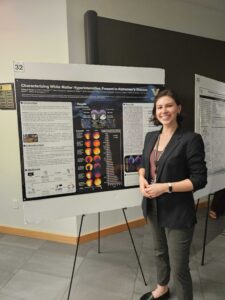
On April 10, 2024, the Vanderbilt Memory and Alzheimer’s Center hosted its fifth Annual Vanderbilt Alzheimer’s Disease Research Day, which included faculty presentations, data blitzes, a keynote presentation, and a poster reception with more than 45 posters. “Big data” was the theme of this year’s VMAC event, but any research touching on Alzheimer’s disease and dementia was welcome.
Several School of Medicine Basic Sciences faculty presented at Alzheimer’s Disease Research Day this year, including Angela Kruse, research instructor in the Department of Cell and Developmental Biology, and Timothy J. Hohman, professor of pharmacology.
In her presentation titled “Multimodal Imaging Mass Spectrometry: Connecting Omics and Imaging to Discover Molecular Drivers of Health and Disease,” Kruse highlighted the work of Claire Scott, graduate student in the Department of Cell and Developmental Biology. “Claire [said] she would heckle me if I made a mistake presenting her data,” Kruse admitted good-naturedly.

Scott’s research focuses on white matter hyperintensities, which indicate lesions in the white matter of the brain and are visible on MRI scans. “They are associated with lower cognition in Alzheimer’s disease and, importantly, they start to show up in individuals far before the development of cognitive symptoms,” Kruse said. But beyond associations with cognitive decline in Alzheimer’s disease patients, the molecular environments of white matter hyperintensities and the background of their formation is poorly understood.
“My research aims to address this knowledge gap by applying a multimodal approach to human Alzheimer’s disease brain tissue,” Scott explained after Kruse’s presentation. She combines MRI, imaging mass spectrometry, immunofluorescent microscopy, among other methods to perform her research. As more data are collected, Scott can begin to computationally distinguish the lipid alterations most indicative of white matter hyperintensities across human donors and investigate the metabolic pathways involved in these changes.
“I thoroughly enjoyed discussing my work with such thoughtful people,” Scott said about the event’s attendees. “The conversations were invigorating and I’m excited to pursue avenues that [we] discussed.”
Presentations continued throughout the day. Hohman, in his talk, discussed the ways experts analyze and integrate data from demographics, imaging, genetics, fluid biomarkers, and the clinic to create various disease models. The “hope and goal is to use these different layers of information” to provide personalized treatment for Alzheimer’s disease.
“We are pretty multidisciplinary team,” Hohman said. “We have folks on the team who focus entirely on genomics. We have people on the team who focus primarily on neuroimaging and cognitive phenotypes. Then we have folks who focus on multi-omics—transcriptomics and proteomics—and integration of the two of these.”
The all-day event also included poster and “data blitz” presentations. Various Basic Sciences community members participated, including Neil Dani, assistant professor of cell and developmental biology, Jared Phillips, graduate student in pharmacology, and Yuting Tan, postdoc in the molecular physiology and biophysics.
For Scott, Alzheimer’s Disease Research Day allowed her to make connections that will help her incorporate more human brain tissue samples into her research. Plus, she learned more about how and what patient data is collected in certain cohorts. For Scott, learning about current data management principles was “very interesting” and, as a researcher, was glad for the opportunity to learn about it. “Overall, I was struck by how nicely the research presented in talks and posters seemed to dovetail in powerful ways,” she said.